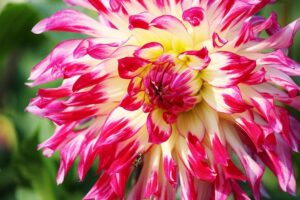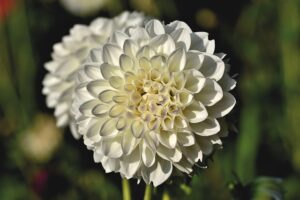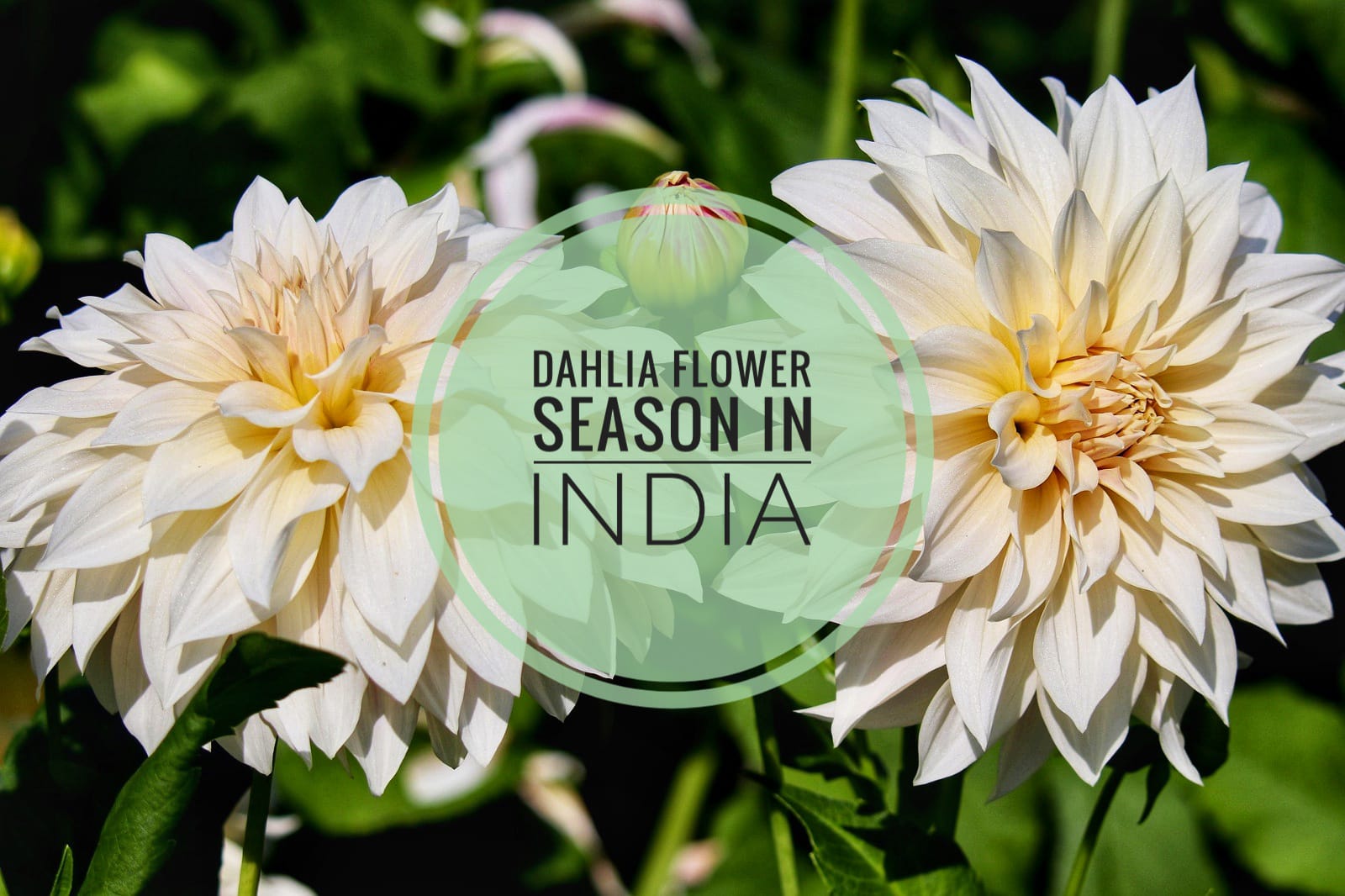It was late winter when we first planted dahlias in our small home garden. Within weeks, their bold colors transformed our space into something out of a painting. If you’ve ever watched these blooms unfold under the mild Indian sun, you already know how magical the dahlia flower season in India can be.
“A garden of dahlias is a garden of joy – every bloom a burst of color and life.”
INTRODUCTION
Dahlias are among the most admired flowering plants in India. Their vibrant colors, unique petal shapes, and long blooming period make them a favorite for both home gardeners and professional landscapers.
The dahlia flower season in India typically runs from late October to March, depending on the region and climate.

Here’s a quick glance at the dahlia’s basic details:
| Feature | Details |
|---|---|
| Scientific Name | Dahlia pinnata |
| Family | Asteraceae |
| Native Region | Mexico and Central America |
| Flowering Season in India | Late October to March |
| Best Growing Regions | North India, hill areas, and cool plains |
| Plant Type | Perennial (grown as annual in many parts) |
| Sunlight Needs | Full sun (6–8 hours daily) |
| Ideal Soil | Well-drained, loamy soil |
| Height Range | 30 cm to 180 cm |
| Colors Available | Red, yellow, pink, purple, orange, white, bicolor |
HISTORY AND ORIGIN
Dahlias trace their origin to Mexico, where they were cultivated long before the arrival of Europeans. The Aztecs valued dahlias not only for their beauty but also for their edible tubers, which were once used as a food source.
The flower was named after the Swedish botanist Anders Dahl, a student of Carl Linnaeus. By the late 18th century, dahlias had reached Europe, where breeders quickly developed hundreds of varieties.
In India, dahlias became popular during the colonial period. Their bright, structured flowers were ideal for formal gardens and competitions. Today, they’re grown widely across the country—from the gardens of Shimla to terraces in Delhi and even in southern hill stations.

GROWING CONDITIONS
To enjoy a full dahlia bloom, it’s essential to understand its growing preferences. These plants love cool, sunny days and well-drained soil.
Soil:
Dahlias grow best in rich, loamy soil with good drainage. Mix in organic compost or well-rotted manure before planting to improve fertility. Avoid waterlogged soil—it can cause tuber rot.
Water:
Keep the soil consistently moist but not soggy. Water deeply twice a week, especially during dry spells. Always water at the base to prevent fungal issues.
Sunlight:
Full sunlight is a must. Dahlias need 6 to 8 hours of direct sunlight daily to produce large, vibrant flowers. In low light, blooms become smaller and stems weaker.
Temperature:
The ideal temperature range for dahlias in India is 15°C to 25°C. They dislike frost and extreme summer heat. In warmer regions, plant them in early winter.
Fertilizer:
Use a balanced fertilizer rich in potassium and phosphorus. Avoid excessive nitrogen—it promotes leaf growth at the cost of flowers.
VARIETIES OF DAHLIA
There are over 40 species and thousands of cultivated varieties of dahlias. They come in many forms—single, double, cactus, pompon and dinner-plate types. Let’s look at a few popular ones grown in India.
1. Single-Flowered Dahlias
These Dahlias have a single row of petals around a visible central disc. The blooms are about 10 cm wide and come in bright shades like orange and yellow.

2. Star Dahlias
Star Dahlias feature small blooms with two or three rows of pointed petals that curve slightly inward, forming a cup around the center.
3. Anemone-Flowered Dahlias
This group stands out for its dense, dome-shaped center made of tubular florets, surrounded by an outer ring of flat petals—creating a unique layered effect.
4. Collarette Dahlias
Collarette Dahlias look similar to singles but have an extra ring of small petals (the collar) that’s about half the length of the outer petals, adding extra detail to the bloom.
5. Paeony-Flowered Dahlias
These have semi-double blooms with a few rows of petals encircling a central disc. The flowers vary in size and resemble the lush form of peonies.
6. Decorative Dahlias
One of the most popular types, Decorative Dahlias produce fully double blooms where the central disc is hidden. Their broad, flat petals end in a blunt point, giving them a rich, layered look.
7. Cactus Dahlias
Like decorative varieties, Cactus Dahlias have fully double blooms, but their petals are narrow, pointed, and often curve backward, resembling cactus spines. They add a dramatic texture to gardens.

8. Double Show and Fancy Dahlias
These flowers are globular and fully double, with incurved tubular petals and small central florets. The blooms are large—over 10 cm in diameter—and make stunning show flowers.
9. Pompom Dahlias
Pompom Dahlias resemble the Double Show varieties but are smaller and tightly rounded. Their neat, compact shape makes them ideal for borders or floral arrangements.

10. Dwarf Bedding Dahlias
Growing only 30 to 60 cm tall, Dwarf Bedding Dahlias are perfect for compact spaces or container gardening. Their flower forms can match any of the types listed above.
Dahlia Flower Season in India
The Dahlia flower season in India brings a splash of color to gardens between October and February. These blooms love cool, sunny weather, making winter the ideal time for their growth across most regions.
Best Time to Plant
In northern India, Dahlias are usually planted in October, while southern regions can start a few weeks earlier due to milder winters. Early planting ensures strong growth and longer flowering.
Growing Conditions
Dahlias thrive in well-drained, fertile soil with plenty of sunlight. They need regular watering but should be kept safe from frost and waterlogging.
A Winter Garden Favorite
With their bold colors and varied shapes, Dahlias brighten up Indian gardens when most other flowers fade. They are among the most rewarding winter blooms for both beginners and seasoned gardeners.
CARE TIPS
Once planted, dahlias don’t need much fuss—just consistent care and attention to detail.
1. Pruning:
Pinch off the top shoot when the plant is about 30 cm tall to encourage bushier growth. Remove dead or faded flowers regularly to promote continuous blooming.
2. Repotting:
For potted dahlias, repot every season. After flowering ends, dig up the tubers, clean them, and store them in a cool, dry place until next planting.
3. Fertilizing:
Feed the plant every 15–20 days with a balanced fertilizer (like NPK 10:20:20). Organic compost tea or bone meal also supports healthy flowering.
4. Propagation:
Dahlias can be propagated by seeds, cuttings or tuber division. Tuber division is the most reliable method—just ensure each section has an eye or bud before replanting.
5. Mulching:
Apply a light mulch of straw or dry leaves to retain soil moisture and suppress weeds.
With regular pruning and feeding, dahlias reward you with weeks of brilliant color and strong, upright stems.
PROBLEMS AND SOLUTIONS
Like any garden favorite, dahlias have their share of challenges. Let’s look at common problems and how to fix them.
1. Aphids and Mites:
These pests suck plant sap and cause leaf curling.
Solution: Spray neem oil or insecticidal soap weekly. Keep the area clean of debris.
2. Powdery Mildew:
White patches on leaves indicate fungal infection.
Solution: Improve air circulation, avoid overhead watering, and use organic fungicide.
3. Tuber Rot:
Overwatering or poor drainage can rot tubers.
Solution: Ensure proper soil drainage and water only when topsoil feels dry.
4. Slugs and Snails:
They feed on young leaves and petals.
Solution: Use crushed eggshells around the base or apply organic slug repellents.
5. Yellowing Leaves:
Can indicate nutrient deficiency or root stress.
Solution: Add compost, ensure proper watering, and maintain soil pH around 6.5–7.0.
USES AND BENEFITS
Ornamental Value:
Dahlias are primarily ornamental. Their striking symmetry and variety make them perfect for garden beds, borders, and floral displays.
Medicinal Uses:
Traditionally, dahlia tubers were used in herbal medicine for treating skin and digestive issues, though modern use is mostly ornamental.
Environmental Benefits:
They attract bees, butterflies, and pollinators, supporting biodiversity in urban gardens.
Cultural Significance:
In India, dahlias are featured in garden competitions and floral exhibitions. They’re often used in festive décor during winter weddings and celebrations.
INTERESTING FACTS ABOUT DAHLIAS
- Dahlias were once the national flower of Mexico, their native country.
- The plant’s tubers are edible and were used as a food crop by the Aztecs.
- Dahlias can produce flowers in nearly every color except true blue.
- There are more than 50,000 named dahlia cultivars worldwide.
- The world’s largest dahlia flower can reach up to 30 cm in diameter.
FREQUENTLY ASKED QUESTIONS
1. When is the best time to plant dahlias in India?
In most Indian regions, the ideal time to plant dahlia tubers is from October to November, when the weather turns cool. This allows the plants to establish well before blooming in winter. In hill areas, planting can start earlier in September.
2. Can dahlias grow in pots?
Yes, dahlias grow beautifully in pots if given proper space and sunlight. Choose medium to large containers with good drainage holes. Use fertile soil mixed with compost, and water regularly without soaking the roots.
3. How long do dahlias bloom in India?
The dahlia flower season in India lasts from late October to March. The peak flowering occurs from December to February. With proper pruning and feeding, blooms can continue for several months.
4. Do dahlias come back every year?
In cooler regions, dahlias behave as perennials, regrowing from tubers each year. In most Indian plains, they are treated as annuals because of summer heat. However, you can dig up and store tubers for replanting next season.
5. How can I make my dahlias bloom more?
Ensure full sunlight, rich soil, and regular feeding. Deadhead spent blooms and pinch growing tips early for bushy growth. Avoid excessive nitrogen fertilizers as they promote leaves instead of flowers.
CONCLUSION
The dahlia flower season in India is a true celebration of color, texture, and life. From hill gardens to city balconies, these blooms brighten every corner they grow in. With just a little care—good soil, enough sun, and timely watering—dahlias reward us with months of beauty.
Thanks for reading. Keep growing, keep exploring, and don’t forget to return here at gardeningbud.com for more plants, tips and gardening wisdom.
